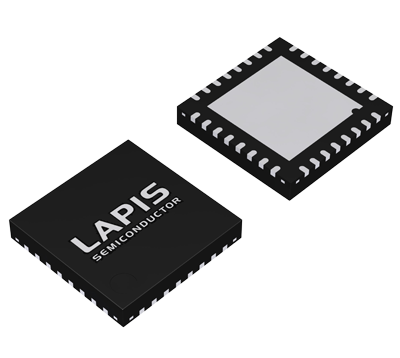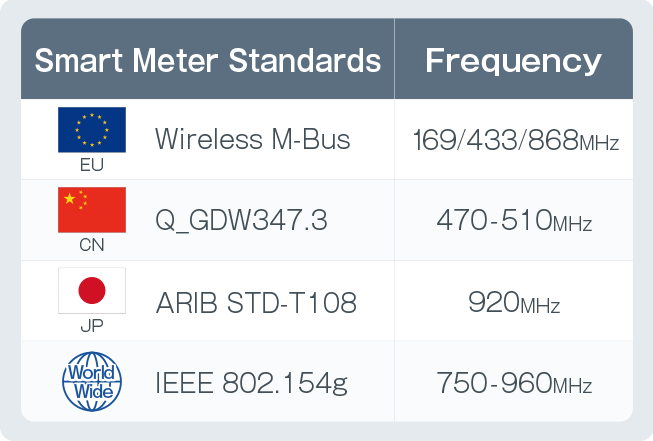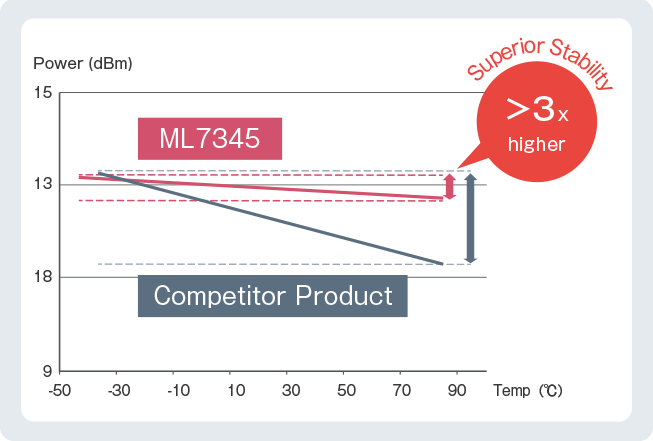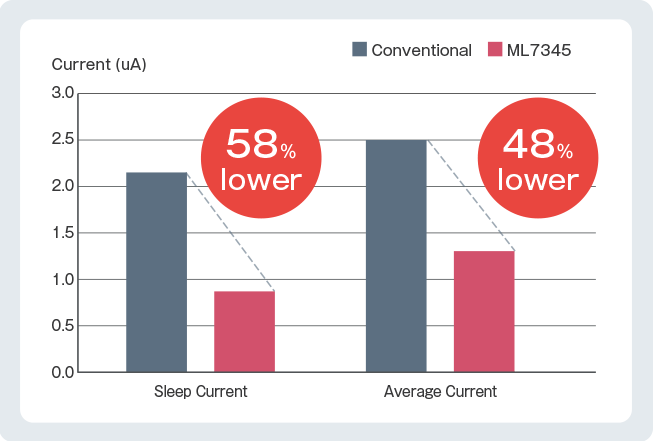LAPIS Semiconductor’s new sub-GHz wireless LSI" ML7345 "
New Wireless Communication LSI Compatible
with Smart Meters Worldwide
Configure wireless networks featuring class-leading reliability and power consumption
Summary

ROHM Group company LAPIS Semiconductor recently announced the availability of a sub-GHz wireless communication LSI optimized for applications requiring low power consumption over relatively long distances, such as smart agriculture, gas/fire alarms, smart meters, and home/building security systems.
In recent years the need to increase energy efficiency in order to mitigate global warming has become a moral and social imperative in all areas. As a result, from 2015 the use of smart meters have increased dramatically throughout Japan, the Wireless M-bus system was launched in Europe, and in China smart meters utilizing different systems (i.e. wireless) were installed. At the same time there is a movement to collect and manage data using wireless networks not only to optimize AC and lighting in offices and buildings and for crime and disaster prevention, but also to improve productivity and yield in primary industries such as agriculture.
LAPIS Semiconductor’s new sub-GHz wireless LSI, which delivers high performance communication with low power consumption, is expected to see wide adoption in smart meters and wireless networks around the world. The ML7345 covers a wide range of sub-GHz frequencies (160MHz to 960MHz), providing universal compatibility.
Improving high-frequency amplifiers makes it possible to achieve class-leading wireless performance and environmental stability (more than 3x the transmission power temperature resistance), simplifying wireless network configuration (i.e. of smart meters) while improving reliability (e.g. reducing the number of relays). In addition, a high-speed radio wave check function that performs receiver startup in a short period of time, combined with significantly reduced sleep current during standby (which accounts for the majority of communication time), decreases average current by 48% compared with conventional products, leading to lower system power consumption and longer battery life. And going forward, LAPIS Semiconductor will continue to simplify wireless device development that contributes to a smarter society.
Key Features
1. Supports a variety of sub-GHz frequencies used throughout the world
- The ML7345 improves high frequency amplifier performance and supports a wide frequency range, from 160MHz to 960MHz.
As a result, adoption is expected in a variety of sub-GHz applications worldwide, from smart meters and telemetry equipment to sensor and wireless networks.
- (1)Compatible with smart meters around the world
- Broad compatibility (160MHz to 960MHz) ensures compliance with the ARIB STD-T108 standard in Japan as well as IEEE802.15.4g, enabling global support for applications such as smart meters and energy management systems (EMS).
- (2)Compliant with the latest Wireless M-bus specifications
- The ML7345 is compliant with the latest (2013) version of the Wireless M-bus standard. Improvements made over the conventional Wireless M-bus packet handler ensures support for the newest extended packet specifications.

- (3)High output (100mW) optimized for the Chinese market [ML7345C]
- ROHM offers an LSI specifically geared for the Chinese market. Along with 100mW antenna output, the ML7345C delivers programmable receiver bandwidth settings that support a wide range of specifications, from electricity, gas, water, and thermal meters to crime and disaster prevention systems.
2. Class-leading environmental stability: Temperature dependence less than ±1dB

- In addition to improving high-frequency amplifier performance, a transmission power variation of less than ±1dB is ensured across the entire operating temperature range, providing more than 3x the stability of conventional products.
This allows for network design without the need to consider margins in response to environmental changes in complicated wireless networks such as smart meters that require multi-hop operation, contributing to lower costs and simpler network configuration (i.e. no relays).
Furthermore, high reliability communication can be achieved in relatively simple wireless networks used for disaster and crime prevention without being affected by changing conditions.
3. High-speed radio wave check function and lower sleep current reduce average current consumption

- Low current consumption design technology cultivated over many years allows LAPIS Semiconductor to decrease average current by 48% during standby operation (in 10-second intervals, which comprise most of the communication time).
In addition, an original high-speed radio wave check function reduces the time required for reception startup, minimizing the total time for receiver strength detection (approx. 1ms). This further decreases current during sleep (when only the timer is ON) to 0.9µA, 58% less than current products. As a result, power consumption of wireless nodes within a network are reduced, contributing to lower overall system power consumption and longer battery life.
4. Complete development support
- An evaluation kit with onboard ML7345 is also available along with reference design data for compact modules (i.e. circuit diagram, peripheral parts list, recommended PCB pattern), multiple test scenarios, and sample programs (simple MAC). Other useful materials, including user manuals and tools, can be downloaded from LAPIS Semiconductor’s website (registration required).
Please refer to the following URL:https://www.lapis-semi.com/cgi-bin/MyLAPIS/regi/login.cgi
【Terminology】
- Wireless M-bus
- A European standard for communication systems for meters and remote reading, specifying an operating frequency of 868MHz in S, C, and T modes, 433MHz in F mode, and 169MHz in N mode.
- ARIB STD-T108
- A wireless equipment standard in Japan for data transmission, telemeters, and telecontrol using the 920MHz band.
- IEEE 802.15.4g
- A wireless standard established by IEEE in the US for smart utility networks.
Applications
- Smart meters worldwide, sensor networks, measurement equipment, and other industrial equipment requiring wireless communication
Sales Plan
- Part No. : ML7345/7345C
- Sample Price (Tentative) :$7.0(tax not included)
- Production Start : December 2015
- Production Qty. : 500,000pcs/month
- Packaging : Tape and reel (2,000pcs/reel)
- Evaluation Board Price : Please contact us for the price from here. (February 26, 2018 Modification to price)
*Please note that the above price is for 1 evaluation board, but 2 boards are required for evaluating transmission/receiving operation
ML7345C Specifications
| Parameter | ML7345C | |
|---|---|---|
| Compatible Frequencies | 160MHz to 960MHz | 470 to 510MHz |
| Modulation Method | 4GFSK / 4GMSK,GFSK / GMSK,FSK / MSK | |
| Transfer Rate | 1200bps to 100kbps | |
| Reception Bandwidth | 1.6kHz to 400kHz | |
| Coding Scheme | NRZ,Manchester ,3 out of 6 | |
| Transmission Power | 20mW/10mW/1mW | 100mW |
| Receiving Sensitivity | -120 dBm @ 2.4kbps to 510MHz |
-120dBm @ 2.4kbps |
| Other | Built-in wakeup and address filter functions | |
| Supply Voltage | 1.8V to 3.6V (1mW) | 3.3V to 3.6V (100mW) |
| Transmission Current | 25mA @ 10mW | 90mA @ 100mW |
| Receiving Current | 8.5mA | |
| Sleep Current (Internal Timer ON) | 0.9µA | |
| Package | 32-pin WQFN | |
Contact
For customers' inquiry regarding this release: please go to ![]() the inquiry page
the inquiry page
* Information in the press releases is current on the date of the press announcement, but is subject to change without prior notice.
*Please note that the names of companies and products described in this document are the trademarks or registered trademarks
of their respective companies and organizations.
Registration
of RSS feed